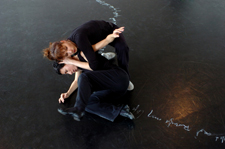It seems only fitting that the inaugural show at Winnipeg’s Contemporary Dancers (WCD) newly re-christened theatre should honour the company’s founder, Rachel Browne, CM, with a rare performance by the Canadian living dance legend.
The final event in WCD’s 2007/08 season, the Browne and Burpee program offered not only a retrospective of Browne’s works dating from 1992 through 2007, but also a world premiere by one of Browne’s protégées, now-Toronto-based independent choreographer/performer and former student of the School of Contemporary Dancers (SCD) Susie Burpee.
On April 23rd, the venue — formerly known as WCD Studio Theatre — was renamed for the company’s seventy-three-year-old dance matriarch. The Philadelphia-born Browne founded WCD in 1964, and has enjoyed a long history as its former artistic director, resident choreographer, teacher, mentor, advisor and friend to its countless dancers over the past forty-odd years. Browne also founded the SCD in 1972, and continues to inspire young dancers by creating new works for its Senior Professional Program each year.
It’s a rare treat to see Browne onstage, with her sense of artistry honed by decades of experience. The eclectic program opens with the poignant “Flowering” (2005), an intergenerational, twenty-minute work performed with SCD Co-Director Odette Heyn-Penner that is moving in its simplicity — superbly crafted while still tugging hard at the heartstrings.
The work begins with the two women, dressed in pedestrian black pants and T-shirts, walking arm in arm in a way that suggests their close relationship. As the lights come up, it quickly becomes clear that the older woman (Browne) serves as a guide, who tenderly takes Heyn-Penner’s arm, strokes her own cheek, or momentarily pushes their hands at the ground as if planting a fertile garden of seeds.
The two dancers do invariably break apart, and then, at the duet’s pivotal moment, the two roles suddenly reverse. As Heyn-Penner circles behind Browne — whose outstretched arms seem to embrace the audience as a gracious act of benevolence — it’s as if the younger woman now carries the torch for future generations. “Flowering” is a beautiful portrait of the artist as an older woman, and a mesmerizing distillation of Browne’s life and career that is truly unforgettable.
The oldest work on the program, “Mouvement” (1992) is a powerful solo that shows the choreographer’s scope of dramatic intensity. Inspired partially by Mexican artist Frida Kahlo’s self-portrait, “The Wounded Deer”, Browne delves into a fantastical world where the dancer portrays both the vulnerability and strength of a surrealistic, deer-woman.
The nine-minute virtuosic work was originally created for former WCD company member Alana Shewchuk, and has been performed many times as one of the choreographer’s signature works. Its newest interpreter, local independent artist Kristin Haight (who joins WCD as a company dancer next season) has taken full ownership of the solo, performing with a bold physicality that becomes increasingly painful to watch. As Haight throws herself against the floor and violently stamps her feet in Browne’s trademark repetitive movement phrases, I became increasingly aware of her claustrophobic entrapment, until her final gasp of defiance that ends the harrowing piece.
“Ceremonies” (2007), originally commissioned by Winnipeg’s Young Lungs Dance Exchange in November 2007, is performed by Johanna Riley, Sarah Roche and Kyla Wallace. Long-time Browne collaborator Ann Southam’s composition “Seastill” provides the soundscore. I found it easily the most ambiguous of the program’s four Browne works, with an abstract movement vocabulary that nevertheless creates several potent images: the dancers stacking their heads atop each other like a totem pole or holding their hands to their leering faces like see- hear- speak-no-evil monkeys. Even more intriguing is Browne’s play with tempo, as the dancers juxtapose high kicks and slow motion rolls to create a kind of textural counterpoint.
The final Browne piece “K.J.4.” features a quartet of graduating students of the Senior Professional Program of the SCD (Arlo Baskier-Nabess, Hilary Bergen, Paige Lewis and Keren Parker), who rhythmically jerk their shoulders in unison to Keith Jarrett’s driving piano score. As the hypnotic work unfolds, the dancers gradually break into individualistic solos like jazz musicians in a late night jam session, their percussive movement becoming more syncopated and wide-reaching. The flashy work proves to be an ideal finish to the first half of the program, and is an admittedly tough act to follow.
The entire second half consists of Burpee’s wittily titled “A Constellation of Scars” (2008), performed to a live score by Winnipeg-based composer/songwriter Christine Fellows (WCD’s Composer in Residence (2007/08)). The program notes describe the forty-five-minute work as “a series of moving and detailed portraits of overlooked creatures”, that “connects warmth and humanity to caricature”. As the two artists’ previous collaborations — including last season’s “The Spinster’s Almanac” (2007) and “The Parlour Rollers” (2007) — have always intrigued, their newest project held great promise, as a much anticipated (half) show.
The vaudevillian-inspired piece begins promisingly as a tableau with Natasha Torres-Garner draped over Fellows’ piano, which immediately establishes a honky-tonk atmosphere. Her plunking out a few notes — upside down and backwards, no less — is a cute touch, but unfortunately, the work only disintegrates from there into a puzzling head-scratcher.
Through a series of progressively weirder vignettes, larger-than-life characters gradually emerge, and I began to feel like Alice falling through the rabbit hole — increasingly trapped (and frankly stumped) by the fragmented images that flew by. I wished wholeheartedly that I could make sense out of Burpee’s disconnected, stream-of-consciousness characterizations, and extract some sort of meaning from it all.
But I couldn’t. Despite a wonderfully strong company of artistically committed dancers (Lise McMillan, Riley, Roche, Torres-Garner and Brendan Wyatt), and fine costumes by Norma Lachance paired with Dean Cowieson’s lighting design, the work suffers from a serious lack of cohesion, with only a few, straggling, singular moments worthy of mention.
Wyatt’s close attention to detail as he creates a mustachioed, grotesquely mugging hunchback, and McMillan’s little-black-dressed coquette are notable, as is the ever-strong Torres-Garner who sits onstage as though paralyzed, watching, until breaking into her own solo where she painfully drags herself around by her arms.
WCD is wise in showcasing one of its brightest stars to graduate from the SCD, with Burpee carrying Browne’s trailblazing creative vision and willingness to take risks into the future. It’s undeniable that Burpee has grown into a highly regarded dance artist in her own right, whose many accolades include prestigious Dora Mavor Moore Awards for Outstanding Performance and Outstanding New Choreography for her duet, “Mischance and Fair Fortune” (2005). She has already proven herself to be a daring, creative explorer, actively seeking to establish her own voice and aesthetic. This is admirable, and is a critically important element of dance making.
But there still has to be a point to it all; otherwise, even the best-intentioned artist can stumble, and like Alice, fall into an artistic vortex of no return. As Fellows’ lyrics prophetically plead, “don’t give up on me quite yet”, near the end of the troubled work, it becomes apparent that, regrettably, it is already far too late.
Tagged: Contemporary, Performance, MB , Winnipeg




